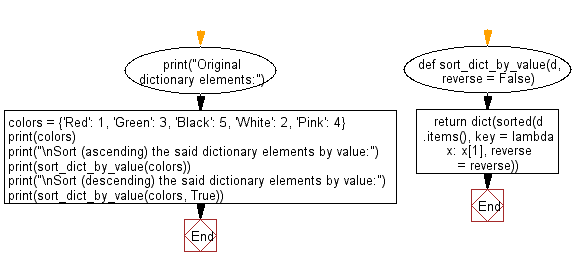Python: Sort (ascending and descending) a dictionary by value
Python dictionary: Exercise-1 with Solution
Write a Python program to sort (ascending and descending) a dictionary by value.
Sample Solution-1:
Python Code:
import operator
d = {1: 2, 3: 4, 4: 3, 2: 1, 0: 0}
print('Original dictionary : ',d)
sorted_d = sorted(d.items(), key=operator.itemgetter(1))
print('Dictionary in ascending order by value : ',sorted_d)
sorted_d = dict( sorted(d.items(), key=operator.itemgetter(1),reverse=True))
print('Dictionary in descending order by value : ',sorted_d)
Sample Output:
Original dictionary : {1: 2, 3: 4, 4: 3, 2: 1, 0: 0}
Dictionary in ascending order by value : [(0, 0), (2, 1), (1, 2), (4, 3), (3, 4)]
Dictionary in descending order by value : {3: 4, 4: 3, 1: 2, 2: 1, 0: 0}
Visualize Python code execution:
The following tool visualize what the computer is doing step-by-step as it executes the said program:
Sample Solution-2:
Note: Dictionary values must be of the same type.
- Use dict.items() to get a list of tuple pairs from d and sort it using a lambda function and sorted().
- Use dict() to convert the sorted list back to a dictionary.
- Use the reverse parameter in sorted() to sort the dictionary in reverse order, based on the second argument.
Python Code:
def sort_dict_by_value(d, reverse = False):
return dict(sorted(d.items(), key = lambda x: x[1], reverse = reverse))
print("Original dictionary elements:")
colors = {'Red': 1, 'Green': 3, 'Black': 5, 'White': 2, 'Pink': 4}
print(colors)
print("\nSort (ascending) the said dictionary elements by value:")
print(sort_dict_by_value(colors))
print("\nSort (descending) the said dictionary elements by value:")
print(sort_dict_by_value(colors, True))
Sample Output:
Original dictionary elements:
{'Red': 1, 'Green': 3, 'Black': 5, 'White': 2, 'Pink': 4}
Sort (ascending) the said dictionary elements by value:
{'Red': 1, 'White': 2, 'Green': 3, 'Pink': 4, 'Black': 5}
Sort (descending) the said dictionary elements by value:
{'Black': 5, 'Pink': 4, 'Green': 3, 'White': 2, 'Red': 1}
Flowchart:

Visualize Python code execution:
The following tool visualize what the computer is doing step-by-step as it executes the said program:
Python Code Editor:
Have another way to solve this solution? Contribute your code (and comments) through Disqus.
Previous: Python Dictionary Exercise Home.
Next: Write a Python program to add a key to a dictionary.
What is the difficulty level of this exercise?
Test your Programming skills with w3resource's quiz.
Python: Tips of the Day
Find current directory and file's directory:
To get the full path to the directory a Python file is contained in, write this in that file:
import os dir_path = os.path.dirname(os.path.realpath(__file__))
(Note that the incantation above won't work if you've already used os.chdir() to change your current working directory, since the value of the __file__ constant is relative to the current working directory and is not changed by an os.chdir() call.)
To get the current working directory use
import os cwd = os.getcwd()
Documentation references for the modules, constants and functions used above:
- The os and os.path modules.
- The __file__ constant
- os.path.realpath(path) (returns "the canonical path of the specified filename, eliminating any symbolic links encountered in the path")
- os.path.dirname(path) (returns "the directory name of pathname path")
- os.getcwd() (returns "a string representing the current working directory")
- os.chdir(path) ("change the current working directory to path")
Ref: https://bit.ly/3fy0R6m
- New Content published on w3resource:
- HTML-CSS Practical: Exercises, Practice, Solution
- Java Regular Expression: Exercises, Practice, Solution
- Scala Programming Exercises, Practice, Solution
- Python Itertools exercises
- Python Numpy exercises
- Python GeoPy Package exercises
- Python Pandas exercises
- Python nltk exercises
- Python BeautifulSoup exercises
- Form Template
- Composer - PHP Package Manager
- PHPUnit - PHP Testing
- Laravel - PHP Framework
- Angular - JavaScript Framework
- Vue - JavaScript Framework
- Jest - JavaScript Testing Framework
